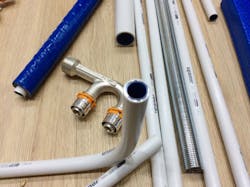Attending the ISH trade show in Germany, as a U.S. mechanical contractor, engages more than just the five senses (sight, hearing, taste, smell and touch). ISH assaults you mentally while you grapple with new concepts and lands a visceral punch to the gut regarding where we are, by comparison, with respect to energy conservation and preservation of natural resources.
So, why is it we are still lagging so far behind in these areas? Government regulations play a huge role.
Our counterparts in Germany are not called contractors. As I discovered during conversations with German attendees at ISH, a contractor is, to them, what a general contractor is to us. We would be known by our specific trade: plumbers, heaters or installers.
Installers and manufacturers are restricted in what types of products can be installed and sold. For example, no induction-motor circulators are permitted and PWM (pulse width modulation) motors will soon be outlawed as well. Only ECM (electrically commutated motor) technology will be installed due to the lower energy consumption. More than 90% of European homes use hydronic heating. No more low-efficiency chimney-vented boilers will be permitted and only modulating-condensing boilers utilizing water temperatures below 140°F are allowed to be installed.
Part of this stems from the fact that homes in Germany are graded on how much energy is used. As Eric, with PAW Hydronic (Paw.eu) explained to me, “Installing a lower-efficiency product would show up in the grading and reduce the value of the real estate.” If you are a plumber or heater installing high-efficiency well-designed systems that take full advantage of the potential operating efficiency, your work will have a higher value.
Jumping back to the U.S., our own government is, once again, pushing for new efficiency regulations to mandate a minimum 92% furnace efficiency. We currently are enjoying a glut of oil, propane (by-product of refining oil) and natural gas. Gasoline happy days are here again and car dealers now have a glut of high-mileage cars while gas-guzzling vehicles are once again selling like hot cakes! Sales of all-electric cars tanked. How quickly we, as a society, forget.
So now will we, as an industry, rail against the government’s intrusion into our sacrosanct right to waste energy? What about all those orphaned water heaters venting into what are now grossly oversized chimneys? Read my column about orphaned water heaters. And read about the proposed DOE rule.
Who’s afraid of the big bad wolf? The 92% mandated efficiency is, let’s be honest, yesterday’s news. And 95% is the new norm, and 98% furnaces are a frequent seller as well. The difference in cost between 92% and 82% efficient furnaces is minimal.
New construction? Compare the installed cost for a furnace with a B-vent chimney to a high-efficiency direct-vent. In retro-fit applications, the only barriers to upgrading to condensing furnaces are the added material cost for venting low-temperature exhaust, dealing with the mildly acidic condensation with possible added cost for neutralizing and pumping, and increase in labor-hours. Under existing conditions, we must up-sell the customer to the higher efficiency. If the government mandates this change, we will need to focus on other opportunities. This will only be a negative if you allow it to be one.
Opportunity knocking
The last time the government attempted to push this furnace upgrade to 92%, one of the more convincing arguments against the proposal was the fact that some situations present virtually impossible barriers to side-wall venting.
The cost to install B-vent (water heater) and PVC exhaust lines in a chimney loomed large. Today, we have available fast and easy flexible polypropylene chimney liners that reduce installation hours dramatically.
Think outside the box. Faced with an orphaned 63% efficient chimney-vented water heater and no way to vent the 92% efficient furnace except by sharing the single-flue chimney? The key, it seems, is dealing with the water heater and tank-style water heaters are seeing a dramatic increase in cost — thanks to the DOE. How much will it cost your customers to replace the water heater? What’s the expense for B-vent or metal flex-vent? Is there room for two flex-vent lines (insulated metal flex and polypropylene flex)? If an exterior chimney, will you be required to add insulation and what are those costs? Ignore the issues at your own peril.
At ISH, you would have seen, literally, thousands of small-dimension modulating/condensing boilers and a myriad of indirect water heaters. Here in the U.S., we have lots of modulating/condensing choices too and widely available hydro-air blowers, or, air handlers into which we can easily incorporate a hydro-coil while ensuring the A/C is not sacrificed in the transition.
Combi tankless 98% efficiency water heaters present yet another option to upgrade the customers’ furnace/water heater to high-efficiency DHW and hydro-air. With the addition of hydronics, you can present additional options to add a bit of radiant heating for the kitchen or bathroom, heated towel bars, and flat panel radiant radiators with their own thermostatic valve. IAQ products can be upgrade options for the air-side too.
Roll with the punches and seize the day!
All Dave Yates material in print and on Contractor's Website is protected by Copyright 2015. Any reuse of this material (print or electronic) must first have the expressed written permission of Dave Yates and Contractor magazine. Please contact via e-mail at: [email protected].
About the Author
Dave Yates
Dave Yates material in print and on Contractor’s Website is protected by Copyright 2017. Any reuse of this material (print or electronic) must first have the expressed written permission of Dave Yates and Contractor magazine.

